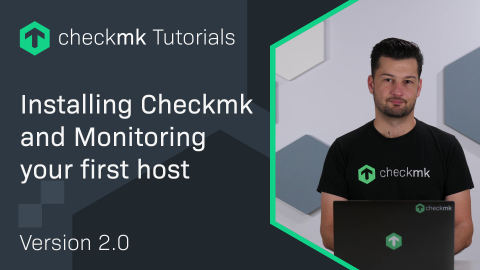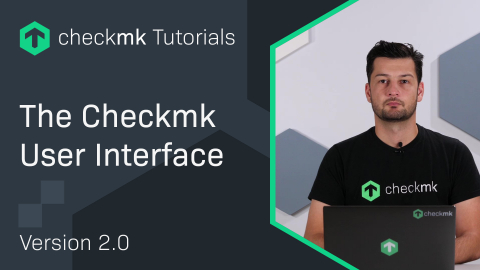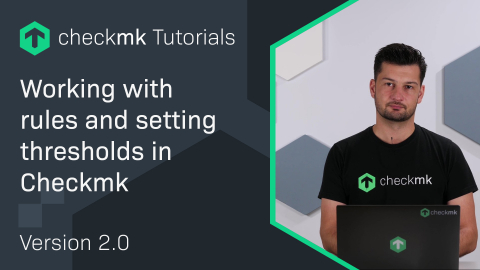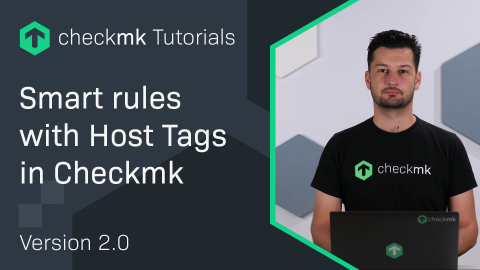Ep. 1: Installing Checkmk & monitoring your first host
Note: All the videos on our website offered in the German language have English subtitles and transcripts, as given below.
| [0:00:11] | Hello, I'm Matthias Kettner from the Checkmk team. |
| [0:00:14] | Today I want to show you how easy it is to get started with Checkmk. |
| [0:00:18] | In this video we will install Checkmk and add some hosts into the monitoring system. |
| [0:00:22] | Before we start however, we should talk about the available editions of Checkmk. |
| [0:00:25] | Checkmk is available in several editions: |
| [0:00:28] | The Raw Edition is 100% open source and is based on a Nagios core. |
| [0:00:32] | The Enterprise Edition is based on our own self-developed monitoring core and has many additional features especially for professional businesses and is available as part of an annual subscription. |
| [0:00:44] | There is also a free version of the Enterprise edition - the Free Edition which has the same features, but it is limited to the monitoring of 10 hosts. |
| [0:00:51] | The Free Edition is very interesting for ambitious home users and small businesses – and it is precisely this Checkmk Free Edition that I want to use in this tutorial. |
| [0:01:01] | To install Checkmk you need a Linux server. |
| [0:01:04] | I already have a Debian 10 installed in a virtual box on my system. |
| [0:01:09] | The first task is to download the software. |
| [0:01:12] | For this we go to the Checkmk homepage, then to 'Download' and there we can already see that the 'Free Edition' is preselected I'll just leave that as it is, as this preselection is also the latest stable version. |
| [0:01:24] | I choose Debian and my version Debian 10. |
| [0:01:31] | You need to enter your email address, after which you can start the download. |
| [0:01:42] | So, the download file is available now, and I'll copy the file with SCP on to my future Checkmk server. |
| [0:01:56] | Next I log in using SSH on the same server and from this step everything is performed on the server. |
| [0:02:06] | Before I install the package, there's one more thing you need to know it is important that the package is installed with all of its dependencies. |
| [0:02:13] | What do we mean by dependency here? |
| [0:02:15] | A dependency is, for example, the Apache web server needed for the graphic interface. |
| [0:02:20] | In the package itself, all of these dependencies are marked and with the correct command Debian will automatically install all of the required packages. |
| [0:02:30] | The easiest way to do this is by using the 'gdebi' command, with which I now with which I now perform the installation, that puts the package into the gdebi-core. |
| [0:02:42] | So with the gdebi command, I'm just going to enter here 'gdebi' without arguments to specify the package, and as you can see, we have now installed Checkmk, but also a whole set of other packages for the operating system. |
| [0:02:59] | How many of these packages will be installed is variable and depends on how many you may have previously installed on your system. |
| [0:03:15] | The next step is to add an instance. Why do we need that? |
| [0:03:19] | Checkmk is able to run multiple instances on one server. |
| [0:03:24] | This is very practical - we can, for example, operate a production instance, and an additional test instance for trying things out. |
| [0:03:32] | Creating the instance is performed with the 'omd create' command, and by specifying a unique name for the instance. |
| [0:03:39] | I use the name 'mysite' as I have done everywhere else in the Checkmk manual. |
| [0:03:43] | You are of course free to choose a name of your own. |
| [0:03:46] | So what happens next here? A directory will be created for the instance in which the data is stored, a Linux user is created which includes the instance name, and a user for the Checkmk web interface named 'cmk admin' is created which receives a randomly-generated password. |
| [0:04:05] | Our first step will be to exchange this password for a new password of your choice. |
| [0:04:08] | To do this, I switch to the instance user with 'su mysite' so I'm just going to be the Linux user which has just been created. |
| [0:04:17] | Now I am in the home directory. The command 'pwd' shows me that the directory is omd / sites / mysite. |
| [0:04:24] | So with the command now visible above, I'll copy that out too. |
| [0:04:31] | I'll just change the password for that of the user of the web interface. |
| [0:04:36] | The only thing I have to do now, the very last one on the command line, is to start the instance the status indicates that this instance is currently stopped. |
| [0:04:46] | This is actually a sort of service or the instance is a set of service processes - and with the command above, 'omd start', |
| [0:04:54] | I can now simply start it. |
| [0:04:56] | If this has all completed successfully, I'm ready to log in to the web interface. |
| [0:05:02] | I'll now change to my browser and in the URL address bar enter 'http' and the IP address for my monitoring server. |
| [0:05:11] | The important thing is the 'slash' and the name of the instance in this case 'mysite'. |
| [0:05:16] | On the login screen I'll log in with 'cmk admin' and the password that I have just set up. |
| [0:05:24] | We can now see the screen of an empty Checkmk system. In the top left you can see the Tactical Overview which shows the number of monitored hosts - at this moment it is 0. |
| [0:05:32] | Also, the 'Main Overview' will not be so interesting since there are no objects in the monitoring yet, so our next step will be to add the first host into the monitoring. |
| [0:05:42] | The entire Checkmk administration takes place on the graphic user interface, in the so-called Web Administration Tool, or 'WATO' for short. WATO can be found in the sidebar if you scroll up a bit - with the mouse wheel, for example. |
| [0:05:55] | There you will find the element WATO Configuration, and here we go to the second item 'Monitor Agents'. |
| [0:06:03] | Why are we doing this? |
| [0:06:04] | First, we want to monitor the monitoring server itself. |
| [0:06:07] | For this we need a Checkmk agent to be installed on the monitoring server, in this case for Linux. |
| [0:06:14] | The Linux agents are available for Debian and Ubuntu in a Debian format, and for Suse and RedHat in a RPM format. |
| [0:06:21] | Should you want to monitor some exotic distribution, then there is also a TGZ format available here. |
| [0:06:28] | So here I'll take the Debian package, and simply download it, go back to my console and log out again so that I'm back on my laptop. |
| [0:06:41] | In the download directory I see the agent which I have just downloaded. |
| [0:06:46] | Now I copy it to the monitoring system, log in with SSH, and as you can see, a second very small file has now appeared - the Checkmk agent. |
| [0:07:12] | I can now, for example, install it again with 'gdebi' if I want to, or with the appropriate tool for your distribution. |
| [0:07:20] | So, you do not have to do much more - the server is now ready to be monitored and I'll return to the web interface. |
| [0:07:30] | Our monitoring server itself is now ready to be monitored. |
| [0:07:34] | For this we now include it in the Checkmk configuration. |
| [0:07:38] | We can find all of this in the WATO configuration menu at the third item called simply - Hosts. |
| [0:07:44] | Here we choose 'Create New Host', using either the big button or the small one above, and the most important thing we enter here is the host name. |
| [0:07:54] | I'm using 'mycmkserver' here. |
| [0:07:57] | You are free to name the host as you wish - it doesn't have to be necessarily the name that is, for example, also used in the DNS. |
| [0:08:03] | If the name is solvable per DNS, then you do not need to configure the IP address. |
| [0:08:09] | I do this, however it isn't the case for my setup, so I activate the option IPv4 address, and enter the server's IP address here. |
| [0:08:21] | The next step is to scroll down to the 'Save & go to Services' button, so that the configuration is saved Checkmk now contacts the agent on the system to be monitored and receives all information about the system from the agent and can determine which services should be monitored. |
| [0:08:46] | I can quickly see here that it has already found quite a number of services. |
| [0:08:50] | What I simply do now is to confirm the whole process by clicking on the 'Monitor' button so that all of the services are added to the monitoring system. |
| [0:09:01] | If I now go up to the top of the page I can see that I have two changes the first was the inclusion of the host, the second was adding the services. |
| [0:09:10] | If I click the '2 services' button, I come to a very important page this is the page with which you can activate changes - this does not happen automatically yet. |
| [0:09:19] | Here below you can also see the two changes 'created new host mycmkserver' and 'saved check configuration' and now I must click the 'Activate affected' button and in a few seconds, those services will be included. |
| [0:09:36] | When I look back in the sidebar at my Tactical Overview I see that I have 1 host and 21 services in the monitoring system. |
| [0:09:45] | Now, when you click on the 'Number of Services' in the Tactical Overview you will get a list with the statuses of all of these 21 services. |
| [0:09:54] | Here we can see that most are green, and one is yellow. |
| [0:09:58] | If you are interested in the details, you can click on the service name for example, here we go to 'CPU Load' where we'll see a detailed view of all information about this service, and also among other things, a graph showing you the history of certain measurements in this case, for example, CPU utilization over time. |
| [0:10:22] | You can find all the details about Checkmk online, in the manual. |
| [0:10:26] | The easiest way is to go to the homepage via the tribe29 logo, then switch to German here, and in the User Portal the first item is the Official Guide. |
| [0:10:37] | If you are a beginner, I highly recommend the new guide to Checkmk for beginners. |
| [0:10:41] | There the installation is described step by step – the first steps being how to add a host, how to monitor SNMP and Windows, how to set up users, how to set up alerts and just about everything you really need to get a basic, or perhaps even a more advanced Checkmk system up and running. |
| [0:10:59] | So that was it for now - many thanks for watching, go try it for yourself, form our download page get the Free Edition which can be set up in a few simple steps and discover how monitoring with Checkmk can be fun. |
| [0:11:11] | Until next time! |
Interested in learning more? Register for a dedicated Synthetic Monitoring training course.








